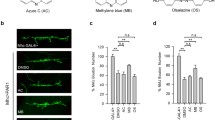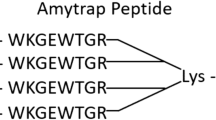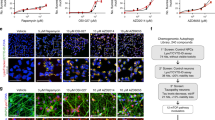Abstract
Tauopathy comprises a group of disorders caused by abnormal aggregates of tau protein. In these disorders phosphorylated tau protein tends to accumulate inside neuronal cells (soma) instead of the normal axonal distribution of tau. A suggested therapeutic strategy for tauopathy is to induce autophagy to increase the ability to get rid of the unwanted tau aggregates. One of the key controllers of autophagy is mTOR. Blocking mTOR leads to stimulation of autophagy. Recently, unravelling molecular structure of mTOR showed that it is formed of two subunits: mTORC1/C2. So, blocking both subunits of mTOR seems more attractive as it will explore all abilities of mTOR molecule. In the present study, we report using pp242 which is a dual mTORC1/C2 blocker in cellular model of tauopathy using LUHMES cell line. Adding fenazaquin to LUHMES cells induced tauopathy in the form of increased phospho tau aggregates. Moreover, fenazaquin treated cells showed the characteristic somatic redistribution of tau. PP242 use in the present tauopathy model reversed the pathology significantly without observable cellular toxicity for the used dosage of 1000 nM. The present study suggests the possible use of pp242 as a dual mTOR blocker to treat tauopathy.


Similar content being viewed by others
References
Betz C, Hall MN (2013) Where is mTOR and what is it doing there? J Cell Biol 203(4):563–574
Caccamo A, Magrì A, Medina DX, Wisely EV, López-Aranda MF, Silva AJ, Oddo S (2013) mTOR regulates tau phosphorylation and degradation: implications for Alzheimer's disease and other tauopathies. Aging Cell 12(3):370–380
Escobar-Khondiker M, Höllerhage M, Muriel M, Champy P, Bach A, Depienne C, Respondek G, Yamada ES, Lannuzel A, Yagi T, Hirsch EC, Oertel WH, Jacob R, Michel PP, Ruberg M, Höglinger GU (2007) Annonacin, a natural mitochondrial complex I inhibitor, causes tau pathology in cultured neurons. J Neurosci 27:7827–7837
Garelick MG, Kennedy BK (2011) TOR on the brain. Exp Gerontol 46:155–163
Höllerhage M, Matusch A, Champy P, Lombès A, Ruberg M, Oertel WH, Höglinger GU (2009) Natural lipophilic inhibitors of mitochondrial complex I are candidate toxins for sporadic neurodegenerative tau pathologies. Exp Neurol 220(1):133–142
Hu F, Liu F (2014) Targeting tissue-specific metabolic signaling pathways in aging: the promise and limitations. Protein Cell 5(1):21–35
Jiang T, JT Y, Zhu XC, Zhang QQ, Cao L, Wang HF (2014) Temsirolimus attenuates tauopathy in vitro and in vivo by targeting hyperphosphorylation and autophagic clearance. Neuropharmacology 85:121–130
Laplante M, Sabatini DM (2012) mTOR signaling in growth control and disease. Cell 149:274–293
Leontieva OV, Blagosklonny MV (2016) Gerosuppression by pan-mTOR inhibitors. Aging (Albany NY) 8(12):3535–3551
Leontieva OV, Demidenko ZN, Blagosklonny MV (2015) Dual mTORC1/C2 inhibitors suppress cellular geroconversion (a senescence program). Oncotarget 6(27):23238–23248
Ludolph AC, Kassubek J, Landwehrmeyer BG, Mandelkow E, Mandelkow EM, Burn DJ, Caparros-Lefebvre D, Frey KA, de Yebenes JG, Gasser T, Heutink P, Höglinger G, Jamrozik Z, Jellinger KA, Kazantsev A, Kretzschmar H, Lang AE, Litvan I, Lucas JJ, PL MG, Melquist S, Oertel W, Otto M, Paviour D, Reum T, Saint-Raymond A, Steele JC, Tolnay M, Tumani H, van Swieten JC, Vanier MT, Vonsattel JP, Wagner S, Wszolek ZK, Reisensburg Working Group for Tauopathies With Parkinsonism (2009) Tauopathies with parkinsonism: clinical spectrum, neuropathologic basis, biological markers, and treatment options. Eur J Neurol 16(3):297–309
Nicks J, Lee S, Harris A, Falk DJ, Todd AG, Arredondo K, Dunn WA Jr, Notterpek L (2014) Rapamycin improves peripheral nerve myelination while it fails to benefit neuromuscular performance in neuropathic mice. Neurobiol Dis 70:224–236
Ozcelik S, Fraser G, Castets P, Schaeffer V, Skachokova Z, Breu K, Clavaguera F, Sinnreich M, Kappos L, Goedert M, Tolnay M, Winkler DT (2013) Rapamycin attenuates the progression of tau pathology in P301S tau transgenic mice. PLoS One 8(5):e62459
Scholz D, Pöltl D, Genewsky A, Weng M, Waldmann T, Schildknecht S, Leist M (2011) Rapid, complete and large-scale generation of post-mitotic neurons from the human LUHMES cell line. J Neurochem 119(5):957–971
Shiryaev N, Jouroukhin Y, Giladi E et al (2009) NAP protects memory, increases soluble tau and reduces tau hyperphosphorylation in a tauopathy model. Neurobiol Dis 34:381–388
Siman R, Cocca R, Dong Y (2015) The mTOR inhibitor rapamycin mitigates perforant pathway neurodegeneration and synapse loss in a mouse model of early-stage Alzheimer-type tauopathy. PLoS One 10(11):e0142340
Skovronsky DM (2007) Tau in Parkinsonian Diseases. In: Dawson TM (ed) Parkinson's disease genetics and pathogenesis. Informa healthcare, New York, pp 187–198
Sousa-Victor P, García-Prat L, Muñoz-Cánoves P (2015) Dual mTORC1/C2 inhibitors: gerosuppressors with potential anti-aging effect. Oncotarget 6(27):23052–23054
Sparks CA, Guertin DA (2010) Targeting mTOR: prospects for mTOR complex 2 inhibitors in cancer therapy. Oncogene 29(26):3733–3744
Takenokuchi M, Kadoyama K, Chiba S et al (2010) SJLB mice develop tauopathy-induced parkinsonism. Neurosci Lett 473:182–185
Tang Z, Bereczki E, Zhang H, Wang S, Li C, Ji X, Branca RM, Lehtiö J, Guan Z, Filipcik P, Xu S, Winblad B, Pei JJ (2013) Mammalian target of rapamycin (mTor) mediates tau protein dyshomeostasis: implication for Alzheimer disease. J Biol Chem 288(22):15556–15570
Wang ZG, Wang Y, Huang Y, Lu Q, Zheng L, Hu D, Feng WK, Liu YL, Ji KT, Zhang HY, XB F, Li XK, Chu MP, Xiao J (2015) bFGF regulates autophagy and ubiquitinated protein accumulation induced by myocardial ischemia/reperfusion via the activation of the PI3K/Akt/mTOR pathway. Sci Rep 5:9287–9298
Xiong J, Kong Q, Dai L, Ma H, Cao X, Liu L, Ding Z (2017) Autophagy activated by tuberin/mTOR/p70S6K suppression is a protective mechanism against local anaesthetics neurotoxicity. J Cell Mol Med 21(3):579–587
Zhang X, Li L, Chen S, Yang D, Wang Y, Zhang X, Wang Z, Le W (2011) Rapamycin treatment augments motor neuron degeneration in SOD1(G93A) mouse model of amyotrophic lateral sclerosis. Autophagy 7(4):412–425
Acknowledgments
The present work was funded by the research grant of Parkinson’s and Movement Disorders Foundation (PMDF, USA-2015), Mansoura University Competitive Research Grants (EGYPT-2016) and International society for Neurochemistry CAEN Category 1B (2017).
Author information
Authors and Affiliations
Contributions
A – research concept and design; B – cell culture and data generation; C – data analysis and interpretation; D – writing the article; E – critical revision of the article; F – final approval of article.
• Mohamed Salama: A, B, C, D, E, F
• Mahmoud Elhussiny: B, C,
• Alshimaa Magdy: B,C
• Ahmed G Omran: B, C
• Aziza Alsayed: B, C
• Ramy Ashry: B,C
• Wael Mohamed: A, D, E, F
Corresponding author
Ethics declarations
Conflict of interest
On behalf of all authors, the corresponding author states that there is no conflict of interest.
Rights and permissions
About this article
Cite this article
Salama, M., Elhussiny, M., Magdy, A. et al. Dual mTORC1/mTORC2 blocker as a possible therapy for tauopathy in cellular model. Metab Brain Dis 33, 583–587 (2018). https://doi.org/10.1007/s11011-017-0137-7
Received:
Accepted:
Published:
Issue Date:
DOI: https://doi.org/10.1007/s11011-017-0137-7




